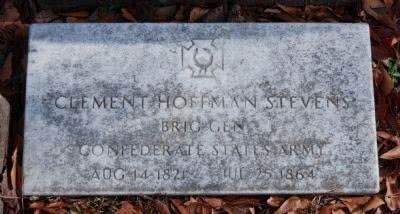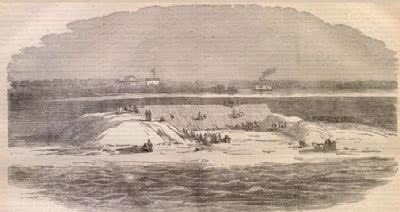Clement Hoffman Stevens
Inscription. [Front]:
Confederate Brig. Gen. Clement H. Stevens (1821-1864) is buried nearby in the Bee family plot. Born in Connecticut, Stevens moved to S.C. after his father’s death in 1836. In 1861 he invented the first ironclad battery, which was built on Cummings Pt. near Charleston and helped bombard Ft. Sumter. As an aide to his brother-in-law Brig. Gen. Barnard E. Bee, he was wounded on 21 July 1861 at First Manassas.
In 1862 Stevens and Ellison Capers formed the 24th S.C. Infantry with Stevens as col. After commanding the 24th in battles from S.C. to Ga. such as Secessionville, Vicksburg, and Chickamauga, he was given a S.C. brigade and promoted to brig. gen. in early 1864. Stevens was mortally wounded on 20 July 1864 at Peachtree Creek near Atlanta, and died 23 July. First buried in Charleston, he was reinterred here.
Additional comments.
1. Brigadier General Clement Stevens
Bee’s brother-in-law, Clement H. Stevens, was born in Norwich, Connecticut, in 1821, but the family soon moved to Pendleton, the hometown of his mother. At the start of the war, he was a banker in Charleston and married to Bee’s sister, giving him some clout in securing a good position in the army. Stevens was the designer of the ‘floating battery’, the wood-and-iron battery that floated in the water and was used against Fort Sumter.
Wounded at First Manassas while serving as an aide to his brother-in-law, Stevens impressed someone enough to secure a commission as a colonel of the 24th South Carolina Infantry. He fought with that unit at the battle of Secessionville on Morris Island south of Charleston. He was then transferred west, where he fought at Vicksburg and Chickamauga. He was wounded again at Chickamauga. Somewhere along the way, his men started calling him ‘Rock.’ Stevens returned to duty as a brigadier general on January 20, 1864. His luck finally ran out on July 20, 1864, when he received his last and fatal wound at the battle of Peachtree Creek, at today’s downtown Atlanta. He died five days later, three years and three days after his brother-in-law. (Source: Touring the Carolinas’ Civil War Sites, Clint Johnson (2003), pages 358.)
By Brian Scott, July 24, 2008
4. Clement Hoffman Stevens Marker – Reverse
2. Brigadier General Barnard Bee
Although a native of Charleston, Bee really considered himself a Texan. His father had moved the family there to become the secretary of state when Texas was still a republic. Bee graduated from West Point in 1845, far down in class ranking. He fought in Mexico and was fighting Indians when he left the army in March 1861 to join South Carolina’s forces. Why he joined a South Carolina unit instead of a Texas one is a bit of a mystery. Bee was made a brigadier general on June 17, 1861, just a month before the war’s first big clash at First Manassas.
In that battle, Bee’s troops were falling back in disarray under pressure from superior Federal forces. Bee was trying to think of something to stem the title when his eye caught another regiment in the rear that was not moving. Behind the regiment, astride a little sorrel horse, was a general clad in a blue uniform. Bee sang out to his troops, ‘There stands Jackson like a stone wall! Rally around the Virginians!’
There have always been two theories about this famous rallying cry. One theory claims that Bee was trying to impress his troops with how coolly the Virginians were holding their ground as the Federals advanced
By Brian Scott, November 27, 2008
5. Clement Hoffman Stevens Tombstone
toward them. The other theory is not at all popular with Virginians. Some historians believe Bee was really cursing Jackson for keeping his troops in the rear when Jackson could plainly see that Bee’s regiments were being cut to pieces. One wonders if Bee’s next most famous call would have been: ‘Jackson, get your butt down here, and help me shoot these Yankees!’ History will never know. Within minutes, Bee was cut down. He died the next day, without knowing that he had created the most famous nickname any general bore during the war. Lieutenant Colonel Thomas J. Jackson, jokingly called ‘Tom Fool’ to that point, would be remembered as ‘Stonewall’ Jackson forever. (Source: Touring the Carolinas’ Civil War Sites, Clint Johnson (2003), pages 357-358.)
? Submitted January 10, 2009, by Brian Scott of Greenville, South Carolina.
Credits. This page originally submitted on July 29, 2008, by Brian Scott of Greenville, South Carolina. This page has been viewed 731 times since then. Photos: 1. submitted on September 30, 2010, by Brian Scott of Greenville, South Carolina. 2. submitted on July 29, 2008, by Brian Scott of Greenville, South Carolina. 3. submitted on September 30, 2010, by Brian Scott of Greenville, South Carolina. 4. submitted on July 29, 2008, by Brian Scott of Greenville, South Carolina. 5, 6, 7. submitted on January 10, 2009, by Brian Scott of Greenville, South Carolina. 8. submitted on September 30, 2010, by Brian Scott of Greenville, South Carolina. 9, 10, 11, 12, 13. submitted on January 10, 2009, by Brian Scott of Greenville, South Carolina. ? Craig Swain was the editor who published this page.Click here to go to the Historic Marker Database to see this listing











